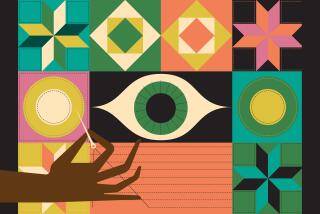Cloth Wall Coverings Are Changing the Fabric of Interior Decorating
It’s curtains for fabrics . . . not to mention tablecloths, upholstery and linens. But putting yards of material up against the wall? People are doing it, says Fran Curl, home decorating manager for the House of Fabrics Superstore in Orange.
“Using fabric (on walls) provides a different look” than wallpaper or paint, Curl says. “Not only can you perfectly match upholstery or bedspreads, but you can add fabric to other pieces, such as headboards or picture frames if you want to further coordinate the look.
“Today, cloth manufacturers frequently make ‘complementary’ materials; that is fabric that coordinates with one or two other fabrics, whether it’s through color coordination or print compatibility,” she says. “Accessorizing also becomes easier. You simply buy more fabric and you have matching pillows, tablecloths and napkins or chair pads. It becomes relatively easy to find ways to continue the pattern on the wall.”
Another benefit of using fabric instead of wallpaper and paint, according to Curl, is that the fabric can be taken down and cleaned or easily replaced, which is especially appealing to families with children.
“With a child’s bedroom, many people decorate the walls with cartoon figures or other popular styles,” she said. “However, in a few years, the child may no longer like the style or may have outgrown the cartoons. Rather than repapering a whole room, you can simply remove the fabric and put up another style.”
Installing fabric is much easier and less messy than wallpapering or painting, according to Curl.
One product, Quik-Trak, which is available at House of Fabric, Cloth World and other national fabric chains, enables decorators to mount plastic tracks on any surface, forming a frame that holds the fabric in place.
“This system is also nice for hanging quilts or woven blankets that decorators want to spotlight,” Curl said. “Others use it as a quick way to skirt a table, bathroom sink or shelf.”
Fabric also can serve as simple and inexpensive room dividers, or in front of bookcases or shelves to provide hidden storage space.
The fabric should be preshrunk before hanging.
Among the fabrics recommended by Curl are antique satin, polished cotton, medium-weight linens, sateen and chintz. Broadcloth and linens provide a more tailored look, while the chintz and sateen have a softer, more romantic feel. Woven fabrics don’t wear as quickly and can add texture to the walls.
“Some of the drapery fabrics work very well because they hold their shape well,” Curl says. The cost for drapery fabrics (which often tend to be a little more expensive than other types of cloth) runs about $12 a foot.
When decorating a wall, the sides of the tracking should be placed side by side, directly adjacent to one another so that there is no gap between each frame.
“It’s really an easy system to install and there is no sewing involved,” Curl said. “The supplies you need are also readily available: tracks, fabric, scissors, staple gun, staples, tape measure and a stepladder.”
The average installation time is about three hours for each wall, Curl says, but isn’t necessary to cover every wall in the room. Covering just one wall will highlight matching accessories or serve as a focal backdrop.

